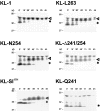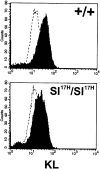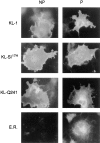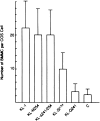Role of dimerization of the membrane-associated growth factor kit ligand in juxtacrine signaling: the Sl17H mutation affects dimerization and stability-phenotypes in hematopoiesis
- PMID: 9565637
- PMCID: PMC2212272
- DOI: 10.1084/jem.187.9.1451
Role of dimerization of the membrane-associated growth factor kit ligand in juxtacrine signaling: the Sl17H mutation affects dimerization and stability-phenotypes in hematopoiesis
Abstract
The Kit ligand (KL)/Kit receptor pair functions in hematopoiesis, gametogenesis, and melanogenesis. KL is encoded at the murine steel (Sl) locus and encodes a membrane growth factor which may be proteolytically processed to produce soluble KL. The membrane-associated form of KL is critical in mediating Kit function in vivo. Evidence for a role of cytoplasmic domain sequences of KL comes from the Sl17H mutation, a splice site mutation that replaces the cytoplasmic domain with extraneous amino acids. Using deletion mutants and the Sl17H allele, we have investigated the role of the cytoplasmic domain sequences of KL in biosynthetic processing and cell surface presentation. The normal KL protein products are processed for cell surface expression, where they form dimers. Both Sl17H and the cytoplasmic deletion mutants of KL were processed to the cell surface; however, the rate of transport and protein stability were affected by the mutations. Deletion of cytoplasmic domain sequences of KL did not affect dimerization of KL. In contrast, dimerization of the Sl17H protein was reduced substantially. In addition, we have characterized the hematopoietic cell compartment in Sl17H mutant mice. The Sl17H mutation has only minor effects on hematopoiesis. Tissue and peritoneal mast cell numbers were reduced in mutant mice as well as in myeloid progenitors. Interestingly, long-term bone marrow cultures from Sl17H mice did not sustain the long-term production of hematopoietic cells. In addition, homing of normal hematopoietic progenitors to the spleen of irradiated Sl17H/Sl17H recipient mice was diminished in transplantation experiments, providing evidence for a role of Kit in homing or lodging. These results demonstrate that the membrane forms of KL exist as homodimers on the cell surface and that dimerization may play an important role in KL/Kit-mediated juxtacrine signaling.
Figures










Similar articles
-
Consequences of exclusive expression in vivo of Kit-ligand lacking the major proteolytic cleavage site.Proc Natl Acad Sci U S A. 1998 Sep 29;95(20):11903-8. doi: 10.1073/pnas.95.20.11903. Proc Natl Acad Sci U S A. 1998. PMID: 9751763 Free PMC article.
-
The presence of novel amino acids in the cytoplasmic domain of stem cell factor results in hematopoietic defects in Steel(17H) mice.Blood. 1999 Sep 15;94(6):1915-25. Blood. 1999. PMID: 10477720
-
The kit-ligand (steel factor) and its receptor c-kit/W: pleiotropic roles in gametogenesis and melanogenesis.Dev Suppl. 1993:125-37. Dev Suppl. 1993. PMID: 7519481 Review.
-
Altered cell-surface targeting of stem cell factor causes loss of melanocyte precursors in Steel17H mutant mice.Dev Biol. 1999 Jun 1;210(1):71-86. doi: 10.1006/dbio.1999.9260. Dev Biol. 1999. PMID: 10364428
-
The c-kit proto-oncogene in normal and malignant human hematopoiesis.Int J Cell Cloning. 1992 Jul;10(4):205-14. doi: 10.1002/stem.5530100403. Int J Cell Cloning. 1992. PMID: 1379619 Review.
Cited by
-
Kit ligand cytoplasmic domain is essential for basolateral sorting in vivo and has roles in spermatogenesis and hematopoiesis.Dev Biol. 2010 Jan 15;337(2):199-210. doi: 10.1016/j.ydbio.2009.10.022. Epub 2009 Oct 27. Dev Biol. 2010. PMID: 19874813 Free PMC article.
-
Regulating dynamic signaling between hematopoietic stem cells and niche cells via a hydrogel matrix.Biomaterials. 2017 May;125:54-64. doi: 10.1016/j.biomaterials.2017.02.013. Epub 2017 Feb 14. Biomaterials. 2017. PMID: 28231508 Free PMC article.
-
Consequences of exclusive expression in vivo of Kit-ligand lacking the major proteolytic cleavage site.Proc Natl Acad Sci U S A. 1998 Sep 29;95(20):11903-8. doi: 10.1073/pnas.95.20.11903. Proc Natl Acad Sci U S A. 1998. PMID: 9751763 Free PMC article.
-
Growth and secretion of erythropoietin of Chinese hamster ovary cells coexpressing epidermal growth factor receptor and erythropoietin genes: Design of cells for cell culture matrix.Cytotechnology. 2001 Jan;35(1):3-8. doi: 10.1023/A:1008192221674. Cytotechnology. 2001. PMID: 19003275 Free PMC article.
-
Point mutation in kit receptor tyrosine kinase reveals essential roles for kit signaling in spermatogenesis and oogenesis without affecting other kit responses.EMBO J. 2000 Mar 15;19(6):1312-26. doi: 10.1093/emboj/19.6.1312. EMBO J. 2000. PMID: 10716931 Free PMC article.
References
-
- Lee DC, Fenton SE, Berkowitz EA, Hissong MA. Transforming growth factor: expression, regulation, and biological activities. Pharmacol Rev. 1995;47:51–85. - PubMed
-
- Bosenberg MW, Massague J. Juxtacrine cell signaling molecules. Curr Opin Cell Biol. 1993;5:823–838. - PubMed
-
- Hill RJ, Sternberg PW. The gene lin-3 encodes an inductive signal for vulval development in C. elegans. . Nature. 1992;358:470–476. - PubMed
-
- Hart AC, Kramer H, Van Vacter DL, Jr, Paidhungat M, Zipursky SL. Induction of cell fate in the Drosophilaretina: the bride of sevenless protein is predicted to contain a large extracellular domain and seven transmembrane segments. Genes Dev. 1990;4:1835–1847. - PubMed
Publication types
MeSH terms
Substances
LinkOut - more resources
Full Text Sources
Other Literature Sources

